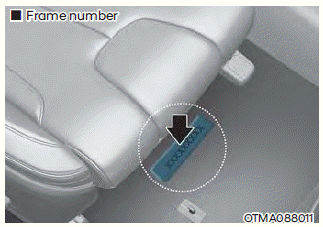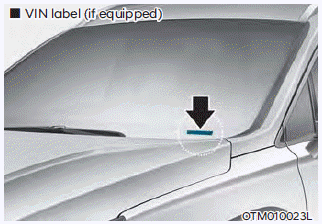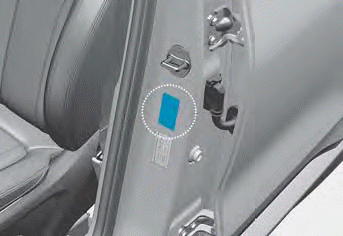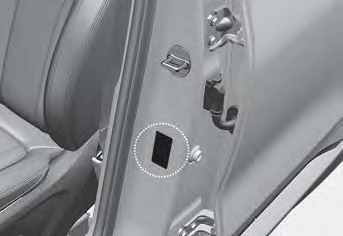 Hyundai Santa Fe (TM): Vehicle Identification Number (VIN). Vehicle certification label. Tire specification
and pressure label
Hyundai Santa Fe (TM): Vehicle Identification Number (VIN). Vehicle certification label. Tire specification
and pressure label
Vehicle Identification Number (VIN)

The vehicle identification number (VIN) is the number used in registering your vehicle and in all legal matters pertaining to its ownership, etc.
The number is punched on the floor under the passenger seat. To check the number, open the cover.

The VIN is also on a plate attached to the top of the left side dashboard. The number on the plate can easily be seen through the windshield from outside.
Vehicle certification label

The vehicle certification label attached on the driver’s (or front passenger’s) side center pillar gives the vehicle identification number (VIN).
Tire specification and pressure label

The tires supplied on your new vehicle are chosen to provide the best performance for normal driving.
The tire label located on the driver’s side center pillar gives the tire pressures recommended for your vehicle.
 Recommended lubricants and capacities
Recommended lubricants and capacities
To help achieve proper engine and powertrain performance and durability, use only lubricants of the proper quality. The correct lubricants also help promote engine efficiency that results in improved fuel ...
 Engine number. Refrigerant label
Engine number. Refrigerant label
Engine number The engine number is stamped on the engine block as shown in the drawing. Refrigerant label The refrigerant label provides information such as refrigerant type and amount. (R-1234yf) ...
See also:
Water Temperature Control Assembly. Repair procedures
Removal 1. Disconnect the battery negative terminal. 2. Loosen the drain plug and drain the engine coolant. 3. Remove the radiator upper hose and lower hose. 4. Disconnect the connectors and then remove ...
If the engine overheats
If your temperature gauge indicates overheating, you experience a loss of power, or hear loud pinging or knocking, the engine is probably too hot. If this happens, you should: 1. Pull off the road and ...
Crankshaft Position Sensor (CKPS). Description and Operation
Description Crankshaft Position Sensor (CKPS) detects the crankshaft position and is one of the most important sensors of the If there is no CKPS signal input, the engine may stop because of CKPS signal ...
